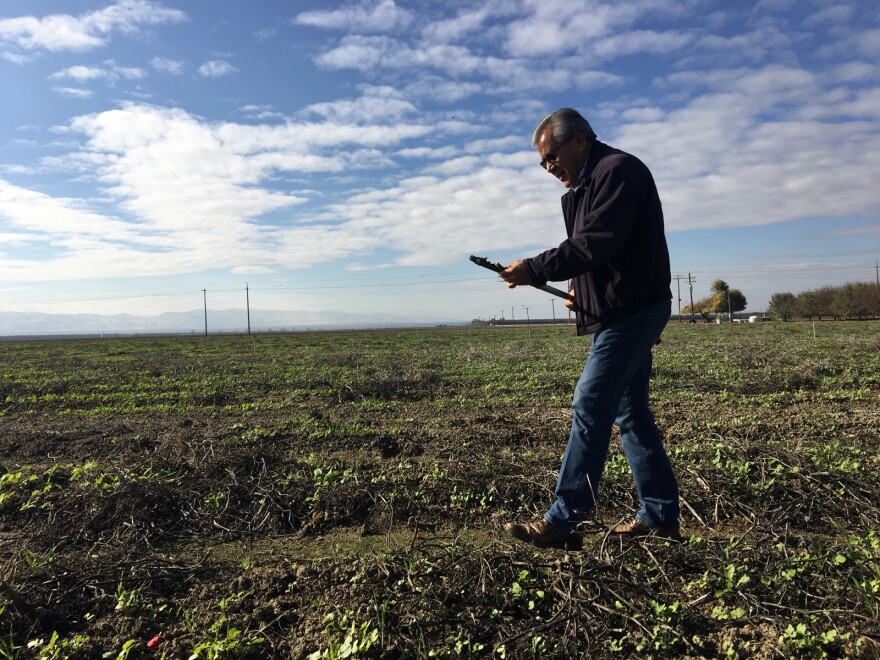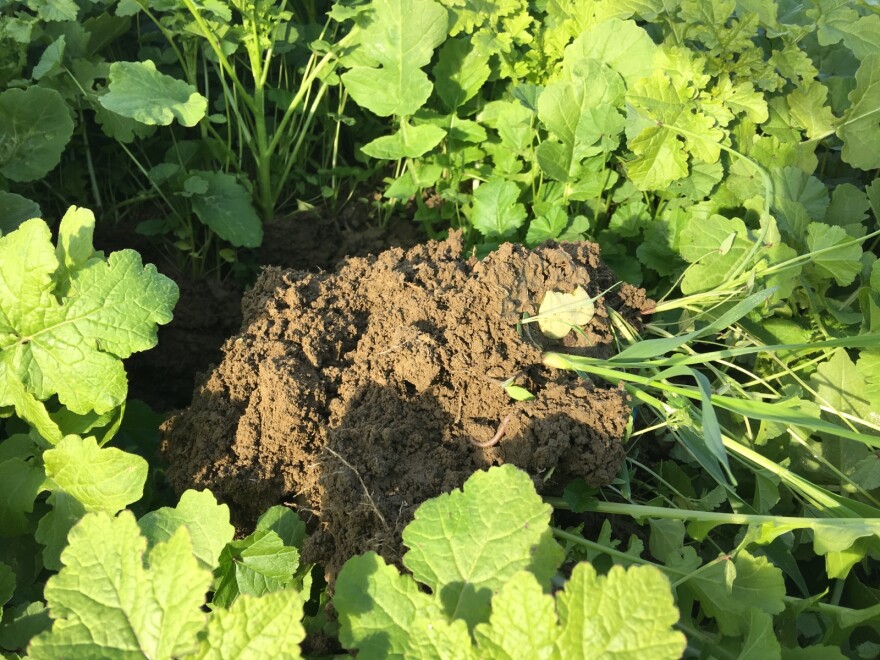We all like to find ways to focus on leading healthy lifestyles. We search out healthy foods, join the gym, and want to breathe clean air. But what about health of the soil that grows our food? As FM89’s Ezra David Romero reports, some valley farmers are turning to cleaning soil in an effort to use less water and to help clean air.
Fifteen years ago tractors could be heard at Sano Farms near Firebaugh on any given day. Now the sound of tractors is rare.
"Soil is the skin of the earth that we all exist on. Our lives are bound up in the health and productivity of soil." - Tom Willey, Organic Farmer
That’s because the 4,000 acre tomato and almond farm has almost stopped running tractors altogether. Farm Manager Jesse Sanchez says he once thought it was a good idea to disc soil often.
“Years ago we used to have 28 tractors working,” Sanchez says Sano farms sold a majority of those tractors. “This year with two or three tractors I do all the work.”
Sanchez has experimented with ideas to enhance soil health for 15 years. He tills a lot less, plants cover crops like mustard greens when tomatoes aren’t in season and he buries drip tape so plants have a direct water source. The result? He uses a third less water, uses 75 percent less diesel to fuel tractors and he cut back on fertilizers.

And according to the California Department of Food and Agriculture his farm could be a model for other growers. Sanchez and USDA Soil Scientist Tony Rolfes are measuring the soils heath by piercing the ground with a metal tube.
“You see the soil is not compacted,” Sanchez says as he and Rolfe smell the soil. Sanchez says if soil is healthy you’ll “like the smell.” It sort of smelt like potting soil. Rolfe’s adds “If it’s bad soil you get a sour, putrid smell.”

But why is soil health so important? Won’t a seed just grow once planted? Not exactly, Sanchez says the healthier soil is, the greater chance plants have to thrive, and they produce more and even yield tastier fruits and veggies. At Sano Farms soil organic matter has grown from about a half percent to three percent. That’s the living part of soil that turns dying plants into minerals needed by growing plants.
“It’s like when you have plenty of good bacteria in your stomach you digest the food a lot better,” Sanchez says. “The same things with the soil. The more bacteria you have is going to give you better results.”
There are also environmental benefits of boosting soil health. Like the soil holding more water and improving air quality. Too much carbon in the air is a bad thing, but in soil it's a plus. That’s why Sanchez doesn’t fallow his farm during the off season. By using a cover crop carbon is sucked out of the atmosphere and captured in the soil year round. UC Cooperative Extension Crop Systems Specialist Jeff Mitchell says a change to this kind of farming can be difficult.
“A real part of the challenge for California farms is the high value nature of the production systems, the crops themselves and some difficult challenges in the great diversity of crops,” says Mitchell.
It's not just large-scale farmers that have utilized climate-friendly farming techniques. Retired Organic Farmer Tom Willey used similar approaches on his farm in Madera and says it's important the general public understands why soil health is so important.
“It’s the survival of our species,” Willey says. “I mean the soil is the skin of the earth that we all exist on. Our lives are bound up in the health and productivity of soil.”
"This is a great opportunity to allow us to build up a program, to work with growers on incentivizing these practices and hopefully make the case for more funding in the future." - Jenny Lester-Moffitt, CDFA

This kind of farming isn’t widely accepted although many farmers have some kind of healthy soils practice in play. That’ because many can’t necessarily afford to change their practices all at once. It took both Sanchez and Willey 15 years or more to get where they’re at today. But that could change with help of the state. CDFA Deputy Secretary Jenny Lester-Moffitt says the state has allotted $7.5 million to incentivize California farmers to further improve soil health and to reduce greenhouse gas emissions.
“This is a great opportunity to allow us to build up a program, to work with growers on incentivizing these practices and hopefully make the case for more funding in the future,” Lester-Moffitt.
The program will hopefully start in January. Growers will have the opportunity to get soil health related farm projects funded and the USDA hopes to set up a few sample projects with the funding to help convince farmers that the investment is worth it. This is a big win for air quality says Renata Brillinger with the California Climate and Agriculture Network. Her group backs the healthy soils initiative and lobbied for the project. She hopes more farmers will apply more climate friendly techniques to their farms.
“We’d like to see it grow but we also look forward to seeing what the appropriate level is dependent on the demand,” Brillinger says. “It’s sort of a chicken and an egg question.”

Back on the farm Jessie Sanchez and Tony Rolfe’s are testing soil health in another field covered with mustard greens. Rolfe’s running through a checklist he uses at farms across the state. He’s looking for moisture and soil density.
“With just some water put it in a cup, well try it,” Rolfe says. “And then we’ll just put a little bit of the soil aggregate into the water to see if it stays together. This one’s holding together pretty well.”
Rolfe’s gives the soil a score of above average. He’s now looking for things crawling in the dirt.
“Oh, there’s a worm,” says Rolfe. “So we’ll give it a three on worms too."
That score is what soil scientists like Rolfe want to see at farms across the region. Sano Farms is ahead of the times when it comes to farming that benefits the environment. But that could change once the state’s healthy soils initiative breaks ground.
There is also technical and financial help for farmers with improving soil health as well as other conservation opportunities from USDA’s Natural Resources Conservation Service. NRCS has 55 offices in California.



